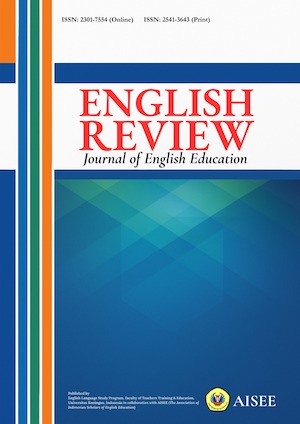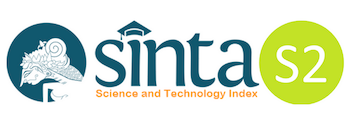THE INTEGRATION OF MOBILE-ASSISTED LANGUAGE LEARNING (MALL) WITH PEER TUTORING METHODS TO ENHANCE MOTIVATION AND ENGAGEMENT AMONG MANAGEMENT STUDENTS
Abstract
This study investigates the impact of integrating Mobile-Assisted Language Learning (MALL) applications with peer tutoring on student engagement, motivation, and learning outcomes in English language Teaching and learning. Utilizing a mixed-methods approach, the research involved pre- and post-intervention surveys, semi-structured interviews, and systematic observations. Quantitative data revealed significant improvements in students' engagement and motivation, with average scores increasing from 2.0 to 3.9 post-intervention. The standard deviation for engagement decreased from 0.7 to 0.5, indicating more consistent student responses. The qualitative analysis provided deeper insights, highlighting that students found MALL applications like Quizlet and YouTube particularly engaging and effective for learning. The thematic analysis of interviews underscored the benefits of peer tutoring in fostering a supportive learning environment, enhancing both collaborative and individual learning experiences. Excerpts from student interviews revealed increased interest and motivation, with students appreciating the flexibility and interactivity of the applications. These findings align with Vygotsky's theory of social constructivism, emphasizing the role of social interaction in learning. The study concludes that the integration of MALL with peer tutoring not only improves student engagement and motivation but also contributes to better language learning outcomes. This has important implications for educational practices and policies, suggesting that incorporating technology and collaborative learning strategies can enhance language education. Future research should explore long-term effects and scalability of such interventions.
References
Acuña, K., & Blacklock, P. J. (2022). Mastery teachers: how to build success for each student in today’s classrooms. Journal of Higher Education Theory and Practice, 22(1). https://doi.org/10.33423/jhetp.v22i1.4970
Adrianto, T., Ilmi, Z., & Heksarini, A. (2020). The Influence of workload and motivation on employee satisfaction and performance Of Pt Gema Soerya Samodra. International Journal of Economics, Business and Accounting Research (IJEBAR), 4(03). https://doi.org/10.29040/ijebar.v4i03.1290
Alamri, H., Lowell, V., Watson, W., & Watson, S. L. (2020). Using personalized learning as an instructional approach to motivate learners in online higher education: Learner self-determination and intrinsic motivation. Journal of Research on Technology in Education, 52(3). https://doi.org/10.1080/15391523.2020.1728449
Alioon, Y., & Delialioğlu, Ö. (2019). The effect of authentic m-learning activities on student engagement and motivation. British Journal of Educational Technology, 50(2). https://doi.org/10.1111/bjet.12559
Amores-Valencia, A., Burgos, D., & Branch-Bedoya, J. W. (2022). Influence of motivation and academic performance in the use of Augmented Reality in education. A systematic review. In Frontiers in Psychology (Vol. 13). https://doi.org/10.3389/fpsyg.2022.1011409
Arco-Tirado, J. L., Fernández-Martín, F. D., & Hervás-Torres, M. (2019). Evidence-based peer-tutoring program to improve students’ performance at the university. Studies in Higher Education. https://doi.org/10.1080/03075079.2019.1597038
Baanqud, N. S., Al-Samarraie, H., Alzahrani, A. I., & Alfarraj, O. (2020). Engagement in cloud-supported collaborative learning and student knowledge construction: a modeling study. International Journal of Educational Technology in Higher Education, 17(1). https://doi.org/10.1186/s41239-020-00232-z
Bedi, A. (2023). Keep learning: Student engagement in an online environment. Online Learning Journal, 27(2). https://doi.org/10.24059/olj.v27i2.3287
Bekteshi, E., & Xhaferi, B. (2020). An analysis of english for specific purposes among university students. Educational Process: International Journal, 9(2). https://doi.org/10.22521/edupij.2020.92.2
Caillaud, S., Doumergue, M., Préau, M., Haas, V., & Kalampalikis, N. (2019). The past and present of triangulation and social representations theory: A crossed history. Qualitative Research in Psychology, 16(3). https://doi.org/10.1080/14780887.2019.1605272
Chibi, M. (2018). The role of the ESP practitioner as business english teacher. International Journal of English Literature and Social Sciences, 3(2). https://doi.org/10.22161/ijels.3.2.12
Chiu, T. K. F. (2022). Applying the self-determination theory (SDT) to explain student engagement in online learning during the COVID-19 pandemic. Journal of Research on Technology in Education, 54(S1). https://doi.org/10.1080/15391523.2021.1891998
Daǧdeler, K. O., Konca, M. Y., & Demiröz, H. (2020). The effect of mobile-assisted language learning (MALL) on EFL learners’ collocation learning. Journal of Language and Linguistic Studies, 16(1). https://doi.org/10.17263/JLLS.712891
DiYanni, R., & Borst, A. (2020). Motivating student learning. In The Craft of College Teaching. https://doi.org/10.2307/j.ctvp2n3jt.7
du Plessis Senior Lecturer, A. J., Young MBus Graduate, C., & Nel, P. (2011). Using elearning, blended learning and digital literacy to improve student engagement and retention. Management Education and Development.
Effectiveness of peer tutoring program on students’ academic performance for engineering course. (2021). International Journal of Service Management and Sustainability, 6(1). https://doi.org/10.24191/ijsms.v6i1.12879
Fachrureza, D., & Suryadana, M. L. (2019). The influence of competence and motivation on employees performance. Kontigensi : Jurnal Ilmiah Manajemen, 7(1). https://doi.org/10.56457/jimk.v7i1.65
Fernández, F., & Arco, J. (2011). Effects of a peer tutoring programme among university students. Infancia y Aprendizaje, 34(1). https://doi.org/10.1174/021037011794390120
Franklin, H., & Harrington, I. (2019). A Review into Effective Classroom Management and strategies for student engagement: Teacher and student roles in today’s classrooms. Journal of Education and Training Studies, 7(12). https://doi.org/10.11114/jets.v7i12.4491
Gatti, L., Ulrich, M., & Seele, P. (2019). Education for sustainable development through business simulation games: An exploratory study of sustainability gamification and its effects on students’ learning outcomes. Journal of Cleaner Production, 207. https://doi.org/10.1016/j.jclepro.2018.09.130
Gelmez, K., & Arkan, S. (2022). Aligning a CAD course constructively: telling-to-peer and writing-to-peer activities for efficient use of CAD in design curricula. International Journal of Technology and Design Education, 32(3). https://doi.org/10.1007/s10798-021-09656-8
Guihang, G., & Miao, Z. (2019). Identity construction of chinese business english teachers from the perspective of ESP theory. International Education Studies, 12(7). https://doi.org/10.5539/ies.v12n7p20
Gutiérrez-colón, M., Frumuselu, A. D., Curell, H., & Gutiérrez-colón, M. (2020). Mobile-assisted language learning to enhance L2 reading comprehension : a selection of implementation studies between 2012 – 2017. Interactive Learning Environments, 0(0), 1–9. https://doi.org/10.1080/10494820.2020.1813179
Harper, R. P., Weston, T. J., & Seymour, E. (2019). Student Responses to problematic STEM teaching methods. In Talking about Leaving Revisited. https://doi.org/10.1007/978-3-030-25304-2_6
Heesen, R., Bright, L. K., & Zucker, A. (2019). Vindicating methodological triangulation. Synthese, 196(8). https://doi.org/10.1007/s11229-016-1294-7
Jakobsen, K. V., & Daniel, D. B. (2019). Evidence-inspired choices for teachers: team-based learning and interactive lecture. Teaching of Psychology, 46(4). https://doi.org/10.1177/0098628319872411
Jeong, K. O. (2022). Facilitating sustainable self-directed learning experience with the use of mobile-assisted language learning. Sustainability (Switzerland), 14(5). https://doi.org/10.3390/su14052894
Kanchana, K. (2016). A study on developing reading skills of engineering students through WhatsApp as motivational strategy. In International Journal of English Research (Vol. 2).
Kay, R., MacDonald, T., & DiGiuseppe, M. (2019). A comparison of lecture-based, active, and flipped classroom teaching approaches in higher education. Journal of Computing in Higher Education, 31(3). https://doi.org/10.1007/s12528-018-9197-x
Lingnau, A. (2019). Designing tomorrow’s classroom with today’s teachers. In Classroom of the Future. https://doi.org/10.1163/9789460911040_011
Maruf, N. (2023). The interplay of teachers’ beliefs, attitudes, and the implementation of differentiated instruction in Indonesian Efl Contexts. English Review: Journal of English Education, 11(2). https://doi.org/10.25134/erjee.v11i2.7251
Maruf, N., & Anjely, A. M. R. (2020). Utilizing cooperative integrated reading and composition (CIRC) with mobile learning to enhance students’ reading comprehension. British (Jurnal Bahasa Dan Sastra Inggris), 9(2), 10–19.
Maruf, N., Asari, S., & Indayani, W. R. (2023). Design and pilot testing of multi-modal language learning environments (Mlles) for Efl students: assessing effectiveness. TELL-US JOURNAL, 9(3). https://doi.org/10.22202/tus.2023.v9i3.7294
Maruf, N., Desembrianita, E., & Husain, D. H. (2021). Identifying ESP course materials for students of magister management: A needs analysis. Budapest International Research and Critics Institute (BIRCI-Journal): Humanities and Social Sciences, 4(3), 5773–5788.
Maruf, N., & Helingo, A. (2022). Assessment strategy to Rectify EFL Students’ Performance: A Need Analysis. JET ADI BUANA, 7(02). https://doi.org/10.36456/jet.v7.n02.2022.6191
Nugrahini, Y. (2019). The influence of MALL (mobile assisted language learning) on English as foreign language students’ reading comprehension. In Organized by Faculty of Letters.
Octavia, H., Widiati, U., & Irawati, E. (2019). Vocational students’ perceptions of mobile assisted language learning (MALL) materials. Jurnal Pendidikan: Teori, Penelitian, Dan Pengembangan, 4(10). https://doi.org/10.17977/jptpp.v4i10.12842
Olulowo, T. G., Ige, O. A., & Ugwoke, E. O. (2020). Using peer tutoring to improve students’ academic achievement in financial accounting concepts. Education Research International, 2020. https://doi.org/10.1155/2020/8871235
Opdecam, E., & Everaert, P. (2019). Choice-based learning: lecture-based or team learning? Accounting Education, 28(3). https://doi.org/10.1080/09639284.2019.1570857
Pawelczak, D. (2017). Comparison of traditional lecture and flipped classroom for teaching programming. https://doi.org/10.4995/head17.2017.5226
Prasetyawati, O. A., & Ardi, P. (2020). Integrating instagram into efl writing to foster student engagement. Teaching English with Technology, 20(3).
Purwantoro, A., Asari, S., & Maruf, N. (2021). The effectiveness of e-learning madrasah in english teaching and learning. BIRCI-Journal, 4(3).
Saunders, P., Chester, A., & Xenos, S. (2020). university student peer tutoring. In Championing Cutting-Edge 21st Century Mentoring and Learning Models and Approaches. https://doi.org/10.1163/9789004440371_003
Seli, H. (2023). Motivation and learning strategies for college success: a focus on self-regulated learning, seventh edition. In Motivation and Learning Strategies for College Success: A Focus on Self-Regulated Learning, Seventh Edition. https://doi.org/10.4324/9781003385271
Simbolon, N. E. (2021). English Medium Instruction (EMI) practice: Higher education internationalization in Indonesia. Englisia: Journal of Language, Education, and Humanities, 8(2). https://doi.org/10.22373/ej.v8i2.8961
Ssemugenyi, F. (2023). Teaching and learning methods compared: A pedagogical evaluation of problem-based learning (PBL) and lecture methods in developing learners’ cognitive abilities. Cogent Education, 10(1). https://doi.org/10.1080/2331186X.2023.2187943
Svalberg, A. M. L. (2009). Engagement with language: Interrogating a construct. Language Awareness, 18(3–4), 242–258. https://doi.org/10.1080/09658410903197264
Tao, J. (Tracy), & Gao, X. (Andy). (2018). Identity constructions of ESP teachers in a Chinese university. English for Specific Purposes, 49. https://doi.org/10.1016/j.esp.2017.09.003
Ullah, I., Tabassum, R., & Kaleem, M. (2018). Effects of peer tutoring on the academic achievement of students in the subject of biology at secondary level. Education Sciences, 8(3). https://doi.org/10.3390/educsci8030112
Vu, T. Van, Magis-Weinberg, L., Jansen, B. R. J., van Atteveldt, N., Janssen, T. W. P., Lee, N. C., van der Maas, H. L. J., Raijmakers, M. E. J., Sachisthal, M. S. M., & Meeter, M. (2022). Motivation-achievement cycles in learning: a literature review and research agenda. In Educational Psychology Review (Vol. 34, Issue 1). https://doi.org/10.1007/s10648-021-09616-7
Vygotsky. (1978). Vygotsky’s social constructivists theory of learning: The zone of proximal development. The Impact of Contructivism on Education: Language, Discourse and Meaning, 5(2002).
Yu, S., Jiang, L., & Zhou, N. (2020). Investigating what feedback practices contribute to students’ writing motivation and engagement in Chinese EFL context: A large scale study. Assessing Writing, 44. https://doi.org/10.1016/j.asw.2020.100451
Yu, S., Zhou, N., Zheng, Y., Zhang, L., Cao, H., & Li, X. (2019). Evaluating student motivation and engagement in the Chinese EFL writing context. Studies in Educational Evaluation, 62. https://doi.org/10.1016/j.stueduc.2019.06.002
Zeng, H. L., Chen, D. X., Li, Q., & Wang, X. Y. (2020). Effects of seminar teaching method versus lecture-based learning in medical education: A meta-analysis of randomized controlled trials. Medical Teacher, 42(12). https://doi.org/10.1080/0142159X.2020.1805100
Zhang, Z., Liu, T., & Lee, C. B. (2021). Language learners’ enjoyment and emotion regulation in online collaborative learning. System, 98. https://doi.org/10.1016/j.system.2021.102478
Zheng, Y., & Yu, S. (2018). Student engagement with teacher written corrective feedback in EFL writing: A case study of Chinese lower-proficiency students. Assessing Writing, 37(January), 13–24. https://doi.org/10.1016/j.asw.2018.03.001
All articles published in English Review: Journal of English Education (ERJEE) are licensed under the Creative Commons Attribution 4.0 International License (CC BY 4.0).
Copyright Ownership
Authors retain the copyright of their articles and grant ERJEE the right of first publication. The journal is granted a non-exclusive license to publish, reproduce, and distribute the article in any format, medium, or platform, provided that proper credit is given to the original authors.
License Terms – CC BY 4.0
Under the Creative Commons Attribution 4.0 International License, others are free to:
- Share — copy and redistribute the material in any medium or format
- Adapt — remix, transform, and build upon the material for any purpose, even commercially
As long as they:
- Provide appropriate credit to the original author(s) and source
- Provide a link to the license (https://creativecommons.org/licenses/by/4.0/)
- Indicate if any changes were made
There are no restrictions on the reuse, reproduction, or adaptation of published articles as long as attribution is properly given.
Author Warranties
By submitting a manuscript to ERJEE, authors confirm that:
- The work is original and does not infringe any existing copyright.
- The manuscript has not been previously published and is not under consideration elsewhere.
- All sources and references are appropriately acknowledged.
- Necessary permissions have been obtained for any copyrighted materials used.









